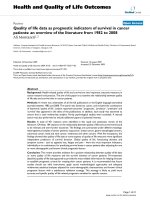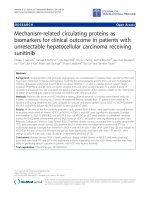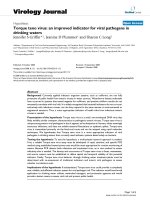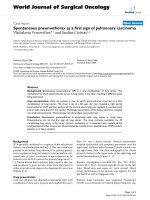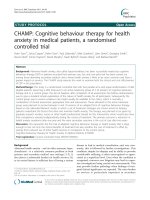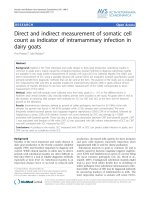Spontaneous pneumothorax as indicator for Birt-Hogg-Dubé syndrome in paediatric patients
Bạn đang xem bản rút gọn của tài liệu. Xem và tải ngay bản đầy đủ của tài liệu tại đây (841.05 KB, 5 trang )
Johannesma et al. BMC Pediatrics 2014, 14:171
/>
CASE REPORT
Open Access
Spontaneous pneumothorax as indicator for
Birt-Hogg-Dubé syndrome in paediatric patients
Paul C Johannesma1, Ben EEM van den Borne2, Johannes JP Gille3, Ad F Nagelkerke4,
JanHein TM van Waesberghe5, Marinus A Paul6, R Jeroen A van Moorselaar7, Fred H Menko8
and Pieter E Postmus1*
Abstract
Background: Birt-Hogg-Dubé syndrome (BHD) is a rare autosomal dominantly inherited disorder caused by
germline mutations in the folliculin (FLCN) gene. Clinical manifestations of BHD include skin fibrofolliculomas, renal
cell cancer, lung cysts and (recurrent) spontaneous pneumothorax (SP). All clinical manifestations usually present in
adults > 20 years of age.
Case presentations: Two non-related patients with (recurrent) pneumothorax starting at age 14 accompanied by
multiple basal lung cysts on thoracic CT underwent FLCN germline mutation analysis. A pathogenic FLCN mutation
was found in both patients confirming suspected BHD. The family history was negative for spontaneous pneumothorax
in both families.
Conclusion: Although childhood occurrence of SP in BHD is rare, these two cases illustrate that BHD should be
considered as cause of SP in children.
Keywords: Birt-Hogg-Dubé syndrome, BHD, Folliculin, FLCN, Spontaneous pneumothorax, Renal cell cancer,
Fibrofolliculomas
Background
Birt-Hogg-Dubé syndrome (BHD) is a rare tumour predisposition syndrome first described in 1977 [1]. The
syndrome is characterized by skin fibrofolliculomas, lung
cysts, (recurrent) spontaneous pneumothorax (SP) and
renal cell cancer. The underlying cause is a germline mutation in the folliculin (FLCN) gene located on chromosome 17p11.2. Clinical manifestation usually appears after
the age of 20 years. We here present two cases of BHD
with episodes of recurrent pneumothorax of which the
first episode occurred at the age of 14 years.
Case presentation
Case 1
A 14-year-old Caucasian boy, without any medical problems in the past, non-smoker, was admitted to the Emergency Department due to shortness of breath and right* Correspondence:
1
Department of Pulmonary Diseases, VU University Medical Center, PO Box
7057, 1007, MB Amsterdam, The Netherlands
Full list of author information is available at the end of the article
sided chest pain which increased when bending over. In
general, he looked healthy and he had no fever. Breath
sounds over the right hemithorax were reduced. Routine
laboratory tests showed no abnormalities. Chest X-ray
showed a right-sided pneumothorax with a complete collapse of the right lung. After drainage by catheter, thoracoscopic pleurodesis was performed. Approximately 8
months later right-sided pneumothorax recurred and was
treated by partial right-sided pleurectomy. In the subsequent two years the patient had another two recurrences,
both treated by catheter drainage. Because of the recurrent
episodes of pneumothorax a CT of his chest was performed, which showed multiple cysts below the level of the
carina in the lung parenchyma adjacent to the visceral
pleura (subpleurally), predominantly on the right side.
(CT-thorax, Figure 1a and b) BHD was suspected and genetic testing confirmed a pathogenic splice-site mutation in
the gene (c.1177-5_1177-3delCTC). Skin fibrofolliculomas
and renal abnormalities were absent in this patient. Subsequently other family members were counselled by the clinical geneticist. Three family members were also affected.
© 2014 Johannesma et al.; licensee BioMed Central Ltd. This is an Open Access article distributed under the terms of the
Creative Commons Attribution License ( which permits unrestricted use,
distribution, and reproduction in any medium, provided the original work is properly credited. The Creative Commons Public
Domain Dedication waiver ( applies to the data made available in this
article, unless otherwise stated.
Johannesma et al. BMC Pediatrics 2014, 14:171
/>
Page 2 of 5
uncomplicated VATS procedure was performed. Although
the thoracic CT showed multiple cysts mainly in the basal
parts of the right lung, none were seen at operation. Total
pleurectomy was performed. Two years later the patient
was referred to our center for evaluation for BHD as this
syndrome had been diagnosed in several family members.
A chest CT now showed several small cysts in both lungs
in the parenchyma and larger cysts resembling ‘bullae’
mainly in the right lung (CT-thorax, Figure 2a and b).
Genetic testing confirmed a pathogenic splice-site mutation (c.1301-7_1304del;1323delCinsGA) of the FLCN
gene., which confirmed the diagnosis of BHD. Skin
fibrofolliculomas and renal abnormalities were absent in
Figure 1 Thoracic CT of case 1. a. CT shows a pneumothorax with
a intraparenchymal located cyst with small septa. b. Shows multiple
cysts in the lower lobes (under the carina), in the same patient after
treatment of the pneumothorax.
The family history was negative for renal cell cancer (RCC)
or (recurrent) episodes of pneumothorax.
Case 2
A 19-year-old Caucasian male presented at the Emergency
Department due to recurrent right-sided pneumothorax.
The first episode had occurred at age 14 and was treated
by video-assisted-thoracoscopic surgery (VATS). A chest
CT now revealed a completely collapsed right lung
with multiple air-filled structures described as bullae
at the ventro-cranial side of the right lower lobe. An
Figure 2 Thoracic CT of case 2. a. CT image of pneumothorax
with a cluster of lung cysts in the right lower lobe. b. Shows a lung
cyst located subpleurally in the right lower lobe, abutting the main
fissure as shown after resolving of the pneumothorax.
Johannesma et al. BMC Pediatrics 2014, 14:171
/>
this patient. Family members had skin fibrofolliculomas,
but no RCC or pneumothorax had been observed.
Conclusions
We report here two paediatric patients with recurrent
spontaneous pneumothorax as a manifestation of the
Birt-Hogg-Dubé syndrome (BHD). Lung cysts were seen
in both patients, predominantly located below the level
of the carina, located subpleurally in the lung parenchyma. The location of these cysts is typical for BHD.
In general, the incidence of paediatric primary and secondary SP is approximately 4 per 100.000 males and 1.1.
per 100.000 females per year, which is much less common
than in adulthood [2,3]. The mean age at presentation of
PSP in paediatric cases is between 13.8-15.9 years and occurs commonly in tall, thin males [4]. A specific racial/
ethnic predominance has not been described in literature
[2]. The underlying cause in spontaneous SP in adulthood
is often unknown in the primary form, but secondary SP
may be due to an inflammatory or connective tissue
disease, infection, malignancy, foreign body aspiration or
congenital malformation [5]. Subpleural bullae, mainly in
the apex of the lung, are found in 76-100 per cent of adult
PSP patients during VATS and thoracotomy [6]. Among
non-smokers with a history of PSP, 81 per cent have bullae
[7]. The general underlying mechanism of PSP in childhood seems to be connective tissue changes, which predispose to spontaneous leaking of air from the airways
into the pleural space. Several case series suggest a relation between subpleural blebs/bullae and the occurrence
of SP [2,8]. The incidence of blebs and bullae detected
on CT in children with SP is between 45% and 100% [9].
The clinical significance of these blebs and bullae remains unclear [4].
SP in children is often diagnosed based on medical history and physical examination, confirmed by chest radiography. The additional value of chest CT is unclear. In the
British Thoracic Society (BTS) guidelines a CT of the
chest is indicated when chest radiography is negative of
clinical signs for SP or for determining appropriate management strategies. Because blebs, bullae and cysts are
only visible on CT, which is performed in a minority of
cases, the diagnosis BHD is likely to be missed.
Adult literature reports a recurrence rate in primary
SP of approximately 30 percent, with a range of 16 to 52
percent [10]. In children a recurrence rate up to 61 percent has been reported and seems to be higher compared
to the adult data [11]. A smaller study by Ouanes-Berbes
et al. reported a 19% overall recurrence rate over 7 year
follow-up in a young adult cohort, with a 72 percent incidence of bullae [12].
In adults, multiple lung cysts are associated with
Birt-Hogg-Dubé syndrome, with a basal rather than apical distribution. The literature on the incidence of BHD
Page 3 of 5
syndrome in adults with PSP is very limited. Ren and
colleagues found a prevalence of 9.8% in 102 apparently
adult SP patients [13]. In a pilot study among 40 apparently primary SP patients we found a pathogenic FLCN
mutation in 3 (7.5%) patients [14].
Previously, SP has been reported twice in paediatric
BHD patients both confirmed by the demonstration of a
pathogenic FLCN-mutation. The first patient had one episode of SP at age of 7 years. Chest CT was not performed.
The second patient at age of 16 years, with a positive
family history for SP, had in total 6 episodes of SP on
both sides with, multiple basally located cysts on chest
CT [15,16]. The youngest BHD patient with pneumothorax we observed was an 18 year old woman with two
episodes of right sided spontaneous pneumothorax with
lung cysts [17].
BHD [OMIM no. 135150] is a rare autosomal dominant
inherited disorder caused by germline mutations in the
(FLCN) gene located on chromosome 17p11.2. The BHD
gene encodes for the protein folliculin which is expressed
in skin, kidney and nephrons and type 1 pulmonary alveolar epithelial cells. The function of folliculin has not been
fully clarified [18,19]. Clinically BHD is characterized by
skin fibrofolliculomas, a 50-fold increased risk for development of (recurrent) SP, multiple lung cysts predominantly
in the basal parts of the lung, renal cysts and renal cancer
from the age of 20 [17,18]. Patients are advised to undergo
lifelong surveillance, preferably by periodic renal MRI or
ultrasound. Because the clinical expression can vary and is
age-dependent, BHD syndrome in patients who present
with pneumothorax cannot be excluded when no renal abnormalities or skin lesions are found [20]. The differential
diagnosis of patients with multiple lung cysts include
emphysema, cystic bronchiectasis, honeycomb change,
cavitated infective nodules, pulmonary Langerhans cell
histiocytosis (LCH), lymphangioleiomyomatosis (LAM),
lymphocytic interstitial pneumonia (LIP), follicular bronchiolitis, amyloidosis, light chain deposition disease (LCDD)
and Birt-Hogg-Dubé (BHD) syndrome [21]. The cystic pattern in BHD differs from that observed in other lung
diseases; In BHD multiple thin-walled pulmonary cysts of
various sizes are observed, predominately distributed to the
lower medial and subpleural regions of the lung with cysts
abutting or including the proximal portion of the lower
pulmonary veins or arteries [22-24].
Treatment of SP in children does not differ from that
in adults and depends on size and underlying cause. Both
BTS and American College of Chest Physicians (ACCP)
have published different recommendations for treatment
of primary SP in adults as well paediatric patients. Multiple studies in adult literature advocate aspiration as a
first treatment option in PSP. For secondary SP or recurrent SP the ACCP and BTS recommend tube thoracostomy and surgical recurrence prevention [2,25]. Whether
Johannesma et al. BMC Pediatrics 2014, 14:171
/>
treatment of pneumothorax in BHD patients needs to
be more aggressive than in idiopathic SP is still under
debate [18].
In conclusion we report here two cases of Birt-HoggDubé syndrome in children with recurrent pneumothorax.
As SP in the paediatric population is relatively rare, BHD
should be considered as underlying cause, especially when
there is a positive family history for pneumothorax, skin
fibrofolliculomas or renal cell cancer. BHD patients are at
increased risk for renal cell cancer and therefore diagnosis
is important for the affected children and their family
members. Therefore we suggest that a thorough family
history, low dose chest CT (with the restraints of using
CT scans in the paediatric population) and easy accessible
genetic testing for BHD are important options for paediatric patients with (recurrent) SP should be performed, even
when skin manifestation are absent. We also suggest more
research is needed on the prevalence of BHD in the
pediatric population with a history of (recurrent) SP.
Consent
Written informed consent was obtained from both patients for publication of this Case report and any accompanying images. Both patients were over the age of 18
when the manuscript was submitted to this journal.
Ethics
The retrospective data collected for this Case report was
part of patient care and was performed in accordance with
the Declaration of Helsinki. Therefore exemption was
granted by our ethics committee. We obtained written informed consent from both patients for publication of this
Case report and any accompanying images. Copy of written consent forms are added as additional supplement.
Conclusions
As SP in the paediatric population is relatively rare, BHD
should be considered as underlying cause, especially when
there is a positive family history for pneumothorax, skin
fibrofolliculomas or renal cell cancer. BHD patients are at
increased risk for renal cell cancer and therefore diagnosis
is important for the affected children and their family
members. Therefore we suggest that a thorough family
history, low dose chest CT (with the restraints of using
CT scans in the paediatric population) and easy accessible
genetic testing for BHD are important options for paediatric patients with (recurrent) SP should be performed, even
when skin manifestation are absent. We also suggest more
research is needed on the prevalence of BHD in the
pediatric population with a history of (recurrent) SP.
Abbreviations
BHD: Birt-Hogg-Dubé syndrome; FLCN: Folliculin; SP: Spontaneous
pneumothorax; CT: Computed tomography; MRI: Magnetic resonance
imaging; VATS: Video assisted thoracoscopic surgery; BTS: British thoracic
Page 4 of 5
society; LCH: Langerhans cell histiocytosis; LAM: Lymphangioleiomyomatosis;
LIP: Lymphocytic interstitial pneumonia; LCDD: Light chain deposition
disease; ACCP: American College of Chest Physicians; PSP: Primary
spontaneous pneumothorax.
Competing interests
All authors have no conflicts of interest to disclose.
Authors’ contributions
PCJ collected the data, provided a substantial contribution to conceptation,
design and drafting/writing of the manuscript, gave final approval of the
version to be published and agreed to be accountable for all aspects of the
work. BEEMvandenB provided a substantial contribution to the drafting/
writing of the manuscript, reviewed and revised it critically, provided the
clinical data of patient case 1 as attending pulmonologist, gave final
approval of the version to be published and agreed to be accountable for all
aspects of the work. JJPG provided the genetic testing and analysis on both
patients. Provided a substantial contribution to review and revise the
manuscript critically, gave final approval of the version to be published and
agreed to be accountable for all aspects of the work. AFN provided a
substantial contribution to review and revise the manuscript critically,
supervised the analysis and interpretation of the clinical patients data,
supervised as attending pediatrician, gave final approval of the version to be
published and agreed to be accountable for all aspects of the work.
JHTMvanW, provided a substantial contribution to review and revise the
manuscript critically, provided and interpreted the thoracic imaging of both
patients as attending radiologist, gave final approval of the version to be
published and agreed to be accountable for all aspects of the work. MAP,
provided a substantial contribution to review and revise the manuscript
critically, provided the clinical data of patient case 1 and 2 as attending
thoracic surgeon, gave final approval of the version to be published and
agreed to be accountable for all aspects of the work. RJAvanM, provided a
substantial contribution to review and revise the manuscript critically, gave
final approval of the version to be published and agreed to be accountable
for all aspects of the work. FHM, provided a substantial contribution to
review and revise the manuscript critically provided the genetic testing on
Folliculin of patient case 1 and 2, contributed as the attending clinical
geneticist of both families, gave final approval of the version to be published
and agreed to be accountable for all aspects of the work. PEP, provided a
substantial contribution to conceptation, design and drafting/writing,
contributed to review and revise the manuscript critically, contributed as
attending pulmonologist of patient case 2, gave final approval of the version
to be published and agreed to be accountable for all aspects of the work.
Acknowledgements
We thank both families with BHD syndrome for their cooperation. We thank
dr. M.M. de Jong, Department of clinical genetics, University Medical Center
Groningen and dr. E. Blom, Department of clinical genetics, Maastricht
University Medical Center, for their contributions in providing a part of the
patient data.
Funding source
No funding was secured for this study.
Financial disclosure
All authors have no financial relationships relevant to this article to disclose.
Author details
1
Department of Pulmonary Diseases, VU University Medical Center, PO Box
7057, 1007, MB Amsterdam, The Netherlands. 2Department of Pulmonary
Diseases, Catharina Hospital, Eindhoven, The Netherlands. 3Department of
Clinical Genetics, VU University Medical Center, Amsterdam, The Netherlands.
4
Department of Paediatrics, VU University Medical Center, Amsterdam, The
Netherlands. 5Department of Radiology, VU University Medical Center,
Amsterdam, The Netherlands. 6Department of Thoracic Surgery, VU
University Medical Center, Amsterdam, The Netherlands. 7Department of
Urology, VU University Medical Center, Amsterdam, The Netherlands. 8Family
Cancer Clinic, Antoni van Leeuwenhoek, The Netherlands Cancer Institute,
Amsterdam, The Netherlands.
Johannesma et al. BMC Pediatrics 2014, 14:171
/>
Received: 19 February 2014 Accepted: 27 June 2014
Published: 3 July 2014
References
1. Birt AR, Hogg GR, Dubé WJ: Hereditary multiple fibrofolliculomas with
trichodiscomas and acrochordons. Arch Dermatol 1977, 133(12):1974–1977.
2. Healthcare Cost and Utilization Project (HCUP): Kids’Inpatient Database (KID). 1997,
2000, 2003, 2006. Available at: />3. Dotson K, Johnson LH: Pediatric spontaneous pneumothorax. Pediatr
Emerg Care 2012, 28(7):715–721.
4. Zganjer M, Cizmic A, Pajic A, Cigit I, Zganjer V: Primary spontaneous
pneumothorax in pediatric patients: our 7-year expercience.
J Laparoendosc Adv Surg Tech A 2010, 20:195–198.
5. Robinson PD, Cooper P, Ranganathan SC: Evidence-based management of
pediatric primary spontaneous pneumothorax. Paediatr Respir Rev 2009,
10(3):110–117.
6. Sahn SA, Heffner JE: Spontaneous pneumothorax. N Engl J Med 2000,
342(12):868–874.
7. Bense L, Lewander R, Eklund G, Hedenstierna G, Wiman LG: Non-smoking,
non-alpha 1-antitypsin deficiency-induced emphysema in non-smokers
with healed spontaneous pneumothorax, identified by computed
tomography of the lungs. Chest 1993, 103:433–438.
8. Smit HJ, Wienk MA, Schreurs AJ, Schramel FM, Postmus PE: Do bullae
indicate a predisposition to recurrent pneumothorax? Br J Radiol 2000,
73:356–359.
9. O’Lone E, Elphick HE, Robinson PJ: Sponatneous pneumothorax in
children: when is invasive treatment indicated? Pediatr Pulmonol 2008,
43(1):41–46.
10. Schramel FM, Postmus PE, Vanderschueren RG: Current aspects of
spontaneous pneumothorax. Eur Respir J 1997, 10:1372–1379.
11. Wilcox DT, Glick PL, Karamanoukian HL, Allen JE, Azizkhan RG: Spontaneous
pneumothorax: a single-institution: 12-year experience in patients under
16 years of age. J Pediatr Surg 1995, 30:1452–1454.
12. Ouanes-Besbes L, Golli M, Knani J, Dachraoui F, Nciri N, El Atrous S,
Gannouni A, Abroug F: Prediction of recurrent spontaneous
pneumothorax: CT scan findings versus management features.
Respir Med 2007, 101:230–236.
13. Ren HZ, Zhu CC, Yang C, Chen SL, Xie J, Hou YY, Xu ZF, Wang DJ, Mu DK,
Ma DH, Wang Y, Ye MH, Ye ZR, Chen BF, Wang CG, Lin J, Qiao D, Yi L:
Mutation analysis of the FLCN gene in Chinese patients with sporadic
and familial associated isolated primary spontaneous pneumothorax.
Clin Genet 2008, 74:178–183.
14. Johannesma PC, Menko FH, Reinhard R, van Waesberghe JHTM, van
Moorselaar RJA, Starink TM, Postmus PE: Primary spontaneous
pneumothorax: a pilot study on the frequency of FLCN mutation
(Birt-Hogg-Dube Syndrome). Am J Respir Crit Care Med 2014, 189:A6417.
15. Bessis D, Giraud S, Richard S: A novel familial germline mutation in the
initiator codon of the BHD gene in a patient with Birt-Hogg-Dubé
syndrome. Br J Dermatol 2006, 155(5):1067–1069.
16. Gunji Y, Akiyoshi T, Sato T, Kurihara M, Tominaga S, Takahashi K, Seyama K:
Mutations of the Birt Hogg Dube gene in patients with multiple lung
cysts and recurrent pneumothorax. J Med Genet 2007, 44(9):588–593.
17. Houweling AC, Gijezen LM, Jonker MA, van Doorn MB, Oldenburg RA,
van Spaendonck-Zwarts KY, Leter EM, van Os TA, van Grieken NC,
Jaspars EH, de Jong MM, Bongers EM, Johannesma PC, Postmus PE,
van Moorselaar RJ, van Waesberghe JH, Starink TM, van Steensel MA,
Gille JJ, Menko FH: Renal cancer and pneumothorax risk in Birt-Hogg-Dubé
syndrome; an analysis of 115 FLCN mutation carriers from 35 BHD families.
Br J Cancer 2011, 105(12):1912–1919.
18. Toro JR, Wei MH, Glenn GM, Weinreich M, Toure O, Vocke C, Turner M,
Choyke P, Merino MJ, Pinto PA, Steinberg SM, Schmidt LS, Linehan WM:
BHD mutations, clinical and molecular genetic investigations of
Birt-Hogg-Dubé syndrome: a new series of 50 families and a review of
published reports. J Med Genet 2008, 45:321–331.
19. Schmidt LS: Birt-Hogg-Dubé syndrome: from gene discovery to
molecularly targeted therapies. Fam Cancer 2013, 12(3):357–364.
20. Menko FH, van Steensel MA, Giraud S, Friis-Hansen L, Richard S, Ungari S,
Nordenskjöld M, Hansen TV, Solly J, Maher ER, European BHD Consortium:
Birt-Hogg-Dubé syndrome: diagnosis and management. Lancet Oncol
2009, 10(12):1199–1206.
21. Clarke BE: Cystic lung disease. J Clin Pathol 2013, 66(10):904–908.
Page 5 of 5
22. Johannesma PC, Thunnissen E, Postmus PE: Lung cysts as indicator for
Birt-Hogg-Dubé. Lung 2014, 192(1):215–216.
23. Tobino K, Gunji Y, Kurihara M, Kunogi M, Koike K, Tomiyama N, Johkoh T,
Kodama Y, Iwakami S, Kikkawa M, Takahashi K, Seyama K: Characteristics of
pulmonary cysts in Birt-Hogg-Dubé syndrome: thin-section CT findings
of the chest in 12 patients. Eur J Radiol 2011, 77:403–409.
24. Kumasaka T, Hayashi T, Mitani K, Kataoka H, Kikkawa M, Tobino K, Kobayashi E,
Gunji Y, Kunogi M, Kurihara M, Seyama: Characterization of pulmonary cysts
in Birt-Hogg-Dubé syndrome: histopathological and morphometric analysis
of 229 pulmonary cysts from 50 unrelated patients. Histopathology 2014.
Jan 7 (in press).
25. MacDuff A, Arnold A, Harvey J, BTS Pleural Disease Guideline Group:
Management of spontaneous pneumothorax: British Thoracic Society
pleural disease guideline 2010. Thorax 2010, 65:ii18–ii31.
doi:10.1186/1471-2431-14-171
Cite this article as: Johannesma et al.: Spontaneous pneumothorax as
indicator for Birt-Hogg-Dubé syndrome in paediatric patients. BMC
Pediatrics 2014 14:171.
Submit your next manuscript to BioMed Central
and take full advantage of:
• Convenient online submission
• Thorough peer review
• No space constraints or color figure charges
• Immediate publication on acceptance
• Inclusion in PubMed, CAS, Scopus and Google Scholar
• Research which is freely available for redistribution
Submit your manuscript at
www.biomedcentral.com/submit
